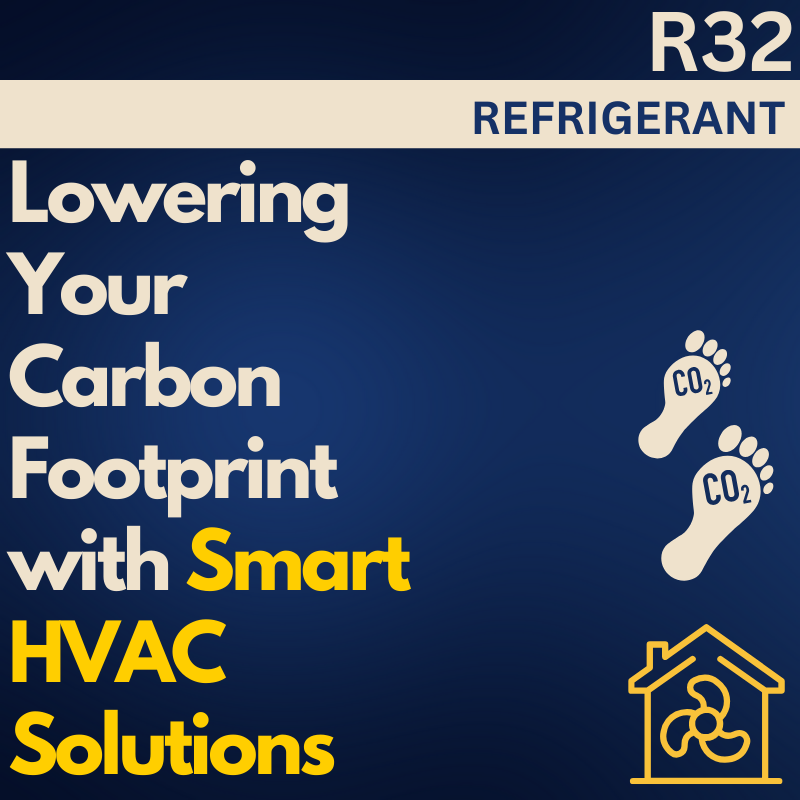As climate change becomes an increasingly urgent global issue, the need for environmentally responsible solutions is more critical than ever. HVAC systems, which play a pivotal role in maintaining indoor comfort, are also significant contributors to greenhouse gas emissions due to the refrigerants they use. Among the latest advancements in HVAC technology, R32 refrigerant stands out as a game-changer, offering a way to lower your carbon footprint while maintaining high efficiency. This blog explores how R32 is helping to create smarter, more sustainable HVAC solutions.
The Environmental Impact of Refrigerants
Refrigerants are essential for the operation of air conditioning and heating systems, but they have traditionally come with environmental drawbacks. Older refrigerants like R22 and R410A, while effective in cooling, have high Global Warming Potential (GWP) and, in the case of R22, also contribute to ozone depletion. As a result, there has been a global push to phase out these harmful substances and replace them with more eco-friendly alternatives.
What is R32?
R32 is a hydrofluorocarbon (HFC) refrigerant that has gained widespread recognition for its lower environmental impact compared to traditional refrigerants. It has a GWP of 675, which is significantly lower than that of R410A, a common refrigerant in many HVAC systems, which has a GWP of 2,088. This reduction in GWP makes R32 a more environmentally friendly option, helping to minimize the HVAC industry’s contribution to global warming.

Discover Top-Grade Air Conditioners: View Our Products Today
-
Reduced Global Warming Potential (GWP):
The most direct way R32 lowers your carbon footprint is through its reduced GWP. Global Warming Potential is a measure of how much heat a greenhouse gas traps in the atmosphere over a specific period, relative to carbon dioxide. A lower GWP means that, if released into the atmosphere, R32 will have a significantly smaller impact on global warming compared to higher-GWP refrigerants like R410A. By choosing HVAC systems that use R32, you are directly contributing to the reduction of greenhouse gases. -
Increased Energy Efficiency:
R32 is not only better for the environment in terms of GWP, but it also enhances the energy efficiency of HVAC systems. R32 has better thermodynamic properties than many other refrigerants, which means it can transfer heat more effectively. This efficiency translates to less energy consumption for the same level of cooling or heating, further reducing the carbon emissions associated with energy production. -
Lower Refrigerant Charge:
One of the benefits of R32 is that it requires a lower refrigerant charge to achieve the same cooling capacity as other refrigerants. This means that HVAC systems using R32 need less refrigerant to operate effectively, which not only reduces the potential for emissions but also lowers the overall environmental impact if a leak occurs. -
Future-Proofing Against Regulations:
As global regulations continue to tighten around the use of high-GWP refrigerants, R32 is well-positioned to meet these evolving standards. For instance, the Kigali Amendment to the Montreal Protocol aims to phase down the use of HFCs like R410A globally. By adopting R32 now, you are not only reducing your current carbon footprint but also ensuring that your HVAC system remains compliant with future regulations, avoiding the need for costly retrofits or replacements.
Smart HVAC Solutions with R32
Beyond its environmental benefits, R32 is also a key component of smart HVAC solutions designed to optimize comfort and efficiency. Here’s how:
-
Compatibility with Modern HVAC Technology:
R32 is compatible with the latest HVAC technologies, including variable speed compressors and advanced control systems. These technologies allow for more precise temperature control and reduced energy consumption, making your HVAC system smarter and more efficient. By integrating R32 into these systems, manufacturers are able to offer products that are both environmentally friendly and technologically advanced. -
Improved System Performance:
HVAC systems that use R32 tend to perform better under a variety of conditions, including extreme temperatures. This improved performance ensures that your home or business remains comfortable year-round while using less energy, which directly contributes to a lower carbon footprint. -
Lower Operating Costs:
The energy efficiency gains from using R32 not only reduce your carbon footprint but also lead to lower operating costs. With energy prices continuing to rise, the cost savings from an R32-based HVAC system can be significant over the lifetime of the equipment. This makes it a smart financial investment as well as an environmental one.
Conclusion: R32 as a Pathway to Sustainability
The adoption of R32 refrigerant represents a significant step forward in the quest for sustainable, high-efficiency HVAC solutions. By lowering Global Warming Potential, increasing energy efficiency, and aligning with global regulatory trends, R32 offers a powerful way to reduce your carbon footprint without compromising on comfort or performance.
For homeowners and businesses alike, choosing an HVAC system that uses R32 is a smart, forward-thinking decision that supports environmental sustainability while delivering practical benefits in terms of efficiency and cost savings. As the world continues to grapple with the challenges of climate change, the move to R32 refrigerant is a clear and actionable way to contribute to a greener future. If you’re looking for an R32 product coming soon we suggest the Goodman 3 Ton 16.4 SEER2 R32 Air Conditioner Condenser.







